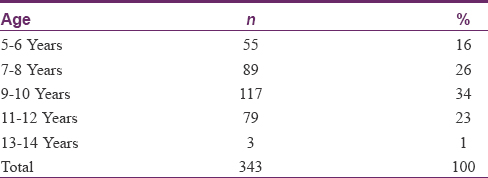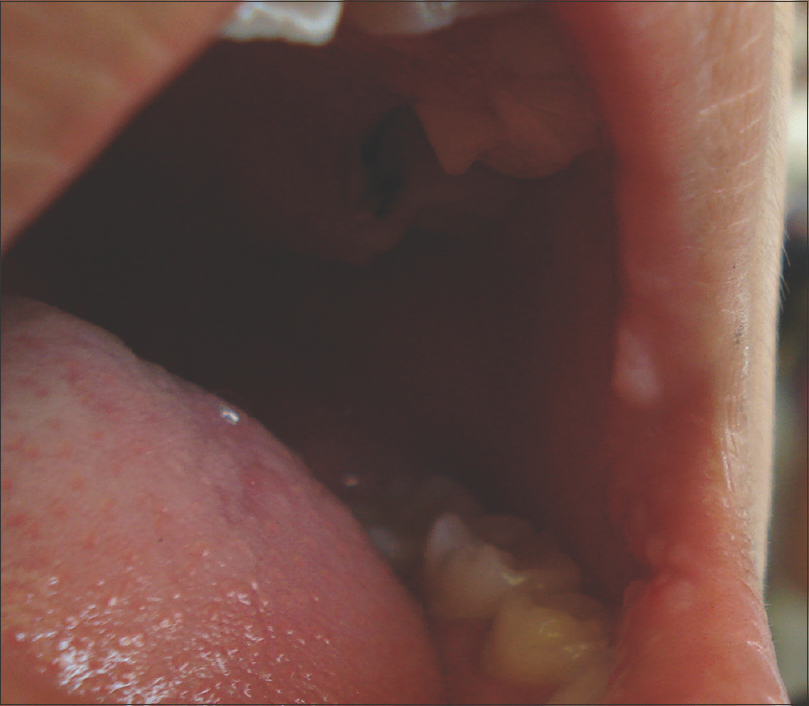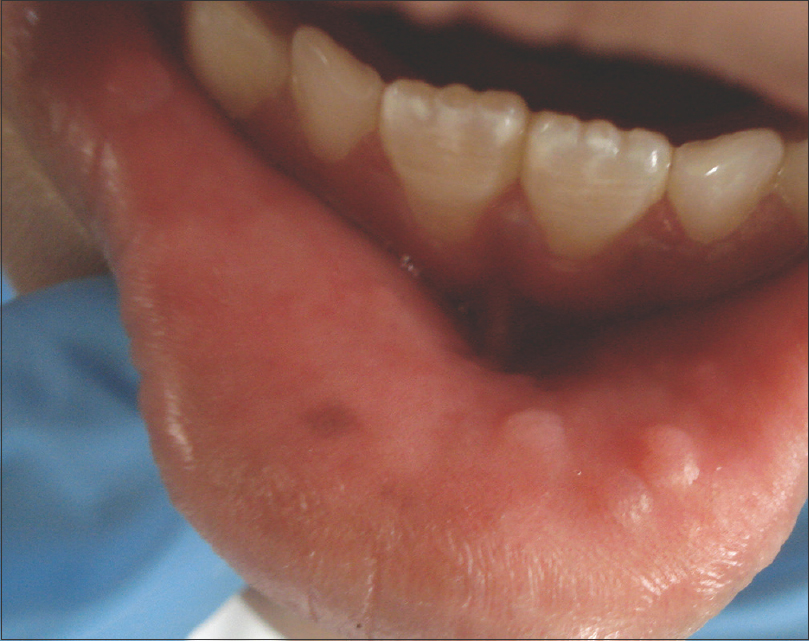Translate this page into:
Unusually high incidence of multifocal epithelial hyperplasia in children of the Nahuatl population of Mexico
2 Division Académica de Ciencias de la Salud, Universidad Juárez Autónoma de Tabasco, Villahermosa, Tabasco, Mexico
Correspondence Address:
Constantino Ledesma-Montes
Ciprés #169-2 Col. Vergel-Coapa, Mexico, D.F. 14320
Mexico
| How to cite this article: Ledesma-Montes C, Mendez-Mendoza A. Unusually high incidence of multifocal epithelial hyperplasia in children of the Nahuatl population of Mexico. Indian J Dermatol Venereol Leprol 2017;83:663-666 |
Abstract
Background: Multifocal epithelial hyperplasia is an uncommon disease of the oral mucosa caused by the human papilloma virus.Aim: To study the clinical and pathological findings of multifocal epithelial hyperplasia detected during an oral examination of 343 Mexican Nahuatl children from a single primary school in El Paso de Cupilco, Mexico.
Methods: A thorough oral examination was performed in all children and clinical data (age, gender, location and number of lesions) were documented and analyzed.
Results: Multifocal epithelial hyperplasia was diagnosed in 110 of the 343 children (32.3%). The ages of the children varied from 5 to 15 years, and of these, 56.3% were girls. The lesions were asymptomatic, 0.2 to 3.0 cm in diameter, soft, round to oval, smooth surfaced, sessile papulonodules, similar in colour to that of the surrounding mucosa. The lesions were commonly seen on the buccal mucosa and tongue, and most affected children (85%) had less than 5 lesions. Children in the 7 to 10 years age group were most often affected.
Limitations: Human papillomavirus typing was not done owing to a lack of facilities.
Conclusions: There is a high incidence of multifocal epithelial hyperplasia in Nahuatl children with a predilection for females.
Introduction
Multifocal epithelial hyperplasia is a benign condition affecting the oral mucosa and is associated with the human papillomavirus types 13 and 32. The lesions are asymptomatic, often numerous, soft, elevated, well-defined nodules, similar in colour to that of the surrounding mucosa. The disease has also been referred to as focal epithelial hyperplasia, Heck disease and multifocal papilloma by other authors. We have earlier suggested that the term multifocal epithelial hyperplasia is more appropriate in that it describes the clinicopathological and microscopic features of the lesions.[8]
Multifocal epithelial hyperplasia is more frequent in certain ethnic groups such as the Eskimos, and Central and South Americans. The incidence varies widely from 0.06% to 33.7% depending upon the population surveyed.[4],[5],[6],[7],[8],[9],[10],[11] It is commonly seen in children, has a predilection for females and occurs more frequently in the lower socio-economic groups. Close relatives are often affected and hence it was earlier considered to be hereditary,[5],[6],[7],[8],[9],[10],[11],[12],[13] but familial transmission through spoons, forks or knives is now considered as more likely.[9] González-Losa et al. showed that human papillomavirus 13 could be detected in saliva of 73% of their studied population.[21]
The Mexican Nahuatl ethnic group is part of the Pina-Nahua branch and the Uto-Aztecan family residing in the area stretching from Mexico to Central America since pre-Hispanic age. Today, Nahuatl ethnic groups live in zones of the Mexican states from the northern area to Tabasco and Chiapas in the southern Mexican zone extending to Central America.[14] We report the clinical and pathological findings of multifocal epithelial hyperplasia in schoolchildren of Nahuatl ancestry and describe the epidemiological characteristics of the this condition.
Methods
Our protocol was approved by the Ethics Committee of the Facultad de Odontología, Universidad Autónoma de Tabasco. The oral cavity of 343 children of the Guillermo Prieto Primary School living in El Paso de Cupilco community of the Tabasco State, Mexico were examined clincially. The age, gender, location, morphological features and number of lesions were documented and analyzed. In addition, a questionnaire was sent to the parents regarding the socio-economic status and the presence of multifocal epithelial hyperplasia lesions in other members of the family. Families with a monthly income of less than $200 US dollars were classified as having a poor socio-economic status.
After an explanation of the purposes of our study, all parents signed a letter of consent giving permission to perform the clinical examination and biopsies of their children. A single lesion was excised in each patient and the tissue was immersed in aqueous neutral formalin solution for 24 hours. The specimen was routinely processed to obtain 5μ thick, paraffin-embedded, hematoxylin- and eosin-stained slides.
Results
Of the 343 children, 220 (64.1%) were girls and the remaining 123 (35.9%) were boys. The ages ranged from 5 to 15 years (mean 9 years). One hundred and ten of these children (32.1%) had lesions of multifocal epithelial hyperplasia (62 girls and 48 boys). The age distribution of the affected children is shown in [Table - 1]. The most commonly affected site was the buccal mucosa (35.8%), followed by tongue (29.6%), upper lip (25%) and lower lip (9.6%). Eighty five percent of the children presented with one to five lesions and the remainder had more than five papules.

The lesions were smooth surfaced, elevated, round or oval, soft, sessile (sometimes pediculated) papules. Rarely, they were corrugated or verrucous. The colour was similar to that of the surrounding mucosa, but in some lesions a whitish hue was noted [Figure - 1], [Figure - 2], [Figure - 3]. The lesions were sessile 95% of the children, but 5% had a small pedicle. They measured from 0.2 to 3.0 cm with a mean size of 1.12 cm. Smaller papules were seen on the buccal mucosa and tongue (range = 0.3–1.5 cm; mean = 0.9 and 0.8 cm, respectively), followed by upper lip nodules (range = 0.2–2.0 cm; mean = 1.1 cm) and the larger nodules were observed on the mucosal surface of the lower lip (range = 0.2–3.0 cm; mean = 1.6 cm). The lesions tended to coalesce on the lower lip and this may have produced the larger nodules.
 |
| Figure 1: Oral mucosa entirely affected with numerous nodules in his buccal, tongue, commissures and lips mucosa |
 |
| Figure 2: Man Nahuatl patient with numerous lesions in tongue, commissures and upper and lower lips mucosa |
 |
| Figure 3: Woman Nahuatl patient showing several lesions in commissures and lower lip mucosa |
The histopathology of the H and E-stained sections revealed uniformly similar features in all the lesions with a parakeratinized, acanthotic, squamous stratified epithelium [Figure - 4], mitosis-like cells and numerous koilocytes [Figure - 5]. The connective tissue was composed of fibroblasts, collagen bundles, some chronic inflammatory cells, capillaries and small nerves.
 |
| Figure 4: In this photomicrograph, we can observe mitosis-like cells and some koilocytes (H and E, ×400) |
 |
| Figure 5: In this photomicrograph, we can observe mitosis-like cells and some koilocytes (H and E, ×400) |
The questionnaire was answered by the mothers of the examined children in every case. There was at least one other member of the family with similar intraoral lesions for every affected child. Unfortunately, no permission for clinical review of these persons was obtained. Typically, these were single income families with the fathers working mainly in agriculture or fishing, and sometimes, breeding domestic animals. The monthly income in all the families was less than 200 US dollars and they were classified as belonging to the poor socioeconomic group.
Discussion
Children and adolescents are most frequently afflicted by multifocal epithelial hyperplasia.[3],[4],[5],[6],[7],[8],[9],[13],[17],[18],[19],[20],[21],[22] The size of the lesions reported in previous studies has ranged from 0.2 to <2 cm.[1],[2],[3],[4],[5],[6],[7],[8],[9],[10],[11],[12],[13],[15],[16],[17],[18],[19],[20],[21],[22] Larger lesions up to 3 cm in diameter were seen in our children especially in those with more severe disease, mostly on the lips, tongue and buccal mucosa. Multifocal epithelial hyperplasia has been reported to afflict the lower lip, buccal mucosae, tongue and commissures in decreasing order of frequency.[10],[17],[18],[22] In our study, the buccal mucosa was most commonly involved, followed by the tongue and lips.
Multifocal epithelial hyperplasia has been studied in populations from different countries [1],[2],[3],[4],[5],[6],[7],[8],[9],[10],[11],[12] as well as in various Mexican ethnic groups.[13],[15],[16],[17],[18],[19],[20],[21] Earlier studies have shown that the Nahuatls living in the Mexican states of Tabasco, Puebla, Queretaro and State of México have a high incidence of multifocal epithelial hyperplasia.[15],[16],[17],[18],[19] Morales-Palacios examined children from the State of Puebla and found no differences in gender or age and that 75% of the brothers exhibited lesions.[13] The incidence of multifocal epithelial hyperplasia in Nahuatl children from the State of Tabasco was approximately 10%,[15],[16] while it was 7.1% in Nahuatl-Mazahuas of the State of México and only 1.9% in Mestizos and 1.2% in Mestizo children.[17],[18] The incidence in adult Nahuatl patients with diabetes mellitus type 2 from the state of Morelos was 6.2%.[19] However, the incidence of multifocal epithelial hyperplasia in the Nahuatl population we studied was much higher (32.1%).
A high incidence of multifocal epithelial hyperplasia has also been reported in other Latin American ethnic groups. In Peruvian children, the incidence of multifocal epithelial hyperplasia was 38.7% while in Venezuelan Indians it was 33.7%.[4] In these studies all the children belonged to the low socioeconomic group.[13],[15],[16],[17],[18],[19],[20],[21],[22]
A major limitation of the study is that viral typing could not be performed.
Conclusions
A high incidence of multifocal epithelial hyperplasia was found in children of the Nahuatl population. The condition was more common in female children of low economic status.
Financial support and sponsorship
Nil.
Conflicts of interest
There are no conflicts of interest.
| 1. |
Estrada L. Informe preliminar sobre algunos aspectos odontológicos de los indios Caramanta. Bol Inst Antropol Antioquia 1956;1:319-21.
[Google Scholar]
|
| 2. |
Estrada L. Estudio médico y odontológico de los indios katios del chocó. Temas Odontol 1960;7:198-210.
[Google Scholar]
|
| 3. |
Reyes DC. Verruga de la cavidad oral. Rev Col Med Guatem 1962;15:23-6.
[Google Scholar]
|
| 4. |
Soneira A, Fonseca CN. Sobre una lesión de la mucosa oral de niños indios de la misión de los ángeles del tokuko. Venez Odontol 1964;29:109-19.
[Google Scholar]
|
| 5. |
Archard HO, Heck JW, Stanley HR. Focal epithelial hyperplasia: An unusual oral mucosal lesion found in Indian children. Oral Surg Oral Med Oral Pathol 1965;20:201-12.
[Google Scholar]
|
| 6. |
Witkop CJ Jr., Niswander JD. Focal epithelial hyperplasia in central and South American Indians and Ladinos. Oral Surg Oral Med Oral Pathol 1965;20:213-7.
[Google Scholar]
|
| 7. |
Carlos R, Sedano HO. Multifocal papilloma virus epithelial hyperplasia. Oral Surg Oral Med Oral Pathol 1994;77:631-5.
[Google Scholar]
|
| 8. |
Ledesma-Montes C, Vega-Memije E, Garcés-Ortíz M, Cardiel-Nieves M, Juárez-Luna C. Multifocal epithelial hyperplasia. Report of nine cases. Med Oral Patol Oral Cir Bucal 2005;10:394-401.
[Google Scholar]
|
| 9. |
Ledesma MC, Torres VM, Garcés OM, López MD. Hiperplasia epitelial focal (enfermedad de Heck). Estudio clínico-patológico. Pract Odontol 1992;13:21-6.
[Google Scholar]
|
| 10. |
Hernández-Jauregui P, Eriksson A, Tamayo-Pérez R, Pettersson U, Moreno-Lopez J. Human papillomaviruses type 13 DNA in focal epithelial hyperplasia among Mexicans. Arch Virol 1987;93:131-7.
[Google Scholar]
|
| 11. |
Henke RP, Guèrin-Reverchon I, Milde-Langosch K, Koppang HS, Löning T. In situ detection of human papillomavirus types 13 and 32 in focal epithelial hyperplasia of the oral mucosa. J Oral Pathol Med 1989;18:419-21.
[Google Scholar]
|
| 12. |
Padayachee A, van Wyk CW. Human papillomavirus (HPV) DNA in focal epithelial hyperplasia by in situ hybridization. J Oral Pathol Med 1991;20:210-4.
[Google Scholar]
|
| 13. |
Morales-Palacios MG, Paz-Bueso R, Tamayo-Pérez R, Hernández-Jáuregui P. Estudio comparativo de prevalencia de hiperplasia epitelial focal en tres grupos poblacionales del estado de Puebla. Rev ADM 1989;46:15-7.
[Google Scholar]
|
| 14. |
Hernández-Hernández N. Presencia contemporánea de los nahuas. Arqueología Mex 2011;19:53-7.
[Google Scholar]
|
| 15. |
Jurisdicción Sanitaria No. 5. Secretaría de Salud. Estado de Tabasco. Reporte de la Presencia de Hiperplasia Epitelial Focal; 2003.
[Google Scholar]
|
| 16. |
Beristain BM. Factores Predisponentes en HEF en Alumnos de la Escuela Primaria Cuauhtémoc, Ranchería La Lagartera del Municipio de Comalcalco. Tabasco. División Académica de Ciencias de la Salud. Universidad Juárez Autónoma de Tabasco; 2006.
[Google Scholar]
|
| 17. |
González B. Hiperplasia epitelial focal en la cavidad bucal. Reporte de casos en dos comunidades del Estado de México. Ciencias Ergosum 1999;6:253-6.
[Google Scholar]
|
| 18. |
Espinosa-Zapata M, Loza-Hernández G, Mondragón-Ballesteros R. Prevalencia de lesiones de la mucosa bucal en pacientes pediátricos. Informe preliminar. Cir Cir 2006;74:153-7.
[Google Scholar]
|
| 19. |
González-Guevara MB, Linares-Vieyra C, Rodríguez-de Mendoza LE. Prevalence of buccal lesions on type 2 diabetes mellitus. Rev Med Inst Mex Seguro Soc 2008;46:237-45.
[Google Scholar]
|
| 20. |
Godoy-Montañez CC, Villamil-Urzáiz JL, González-Losa MR, González EM. Hiperplasia epitelial multifocal/enfermedad de heck. Rev Mex Odontol Clin 2008;2:18-9.
[Google Scholar]
|
| 21. |
González-Losa MR, Suarez-Allén RE, Canul-Canche J, Conde-Ferráez L, Eljure-Lopez N. Multifocal epithelial hyperplasia in a community in the Mayan area of Mexico. Int J Dermatol 2011;50:304-9.
[Google Scholar]
|
| 22. |
Guevara A, Blondet J, Llerena V. Prevalencia y distribución de la hiperplasia epitelial focal en la población escolar de Mórrope-Lambayeque-Perú. Folia Dermatol 2003;14:15-20.
[Google Scholar]
|
Fulltext Views
3,387
PDF downloads
2,121





